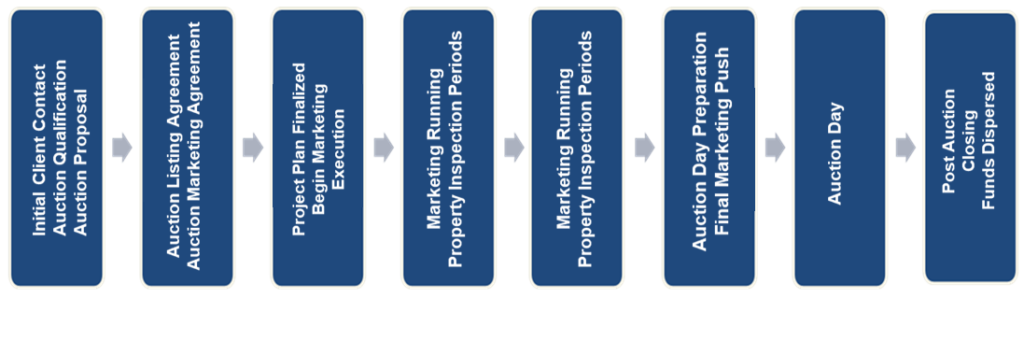AUCTION TIMELINE
Auction procedures might sound intimidating at first, but the process is actually quite simple. The timeline for an auction varies depending on what is selling, but a typical auction will be about 30 to 90 days from the initial client consultation to closing.

The first step is an initial client consultation with your potential seller. The information collected during this consultation is vital to you and the seller.
You will:
- Identify Seller’s Goals, Motivation and Timing
- Situational Analysis
- Ability to fund auction marketing campaign
- Auction Format: Absolute/Reserve
- Driving factors of the auction: market analysis, competitive analysis
- Property and client qualification for auction
- Auction proposal development
For more information about this step, visit the Auction Prospecting Strategies section of this manual
Next up is creating an auction listing agreement/auction listing contract and gathering property information including:
- Items needed for an auction listing agreement: auction type & format, auction date, auction location, contract term, buyer’s premiums and/or commissions, bid deposit requirements, down payment requirements, closing & title information, dispute resolution; etc.
- Collect relevant property, seller and broker/agency disclosures.
- Collect property information: property description, restrictions, appraisals, tax information, title commitment, maps (survey, topo, plat, soil, etc.), leases, income production reports, condition or environmental reports; etc.
- Define the responsibilities of each party
For more information about this step, visit the Auction Listing Strategies section of this manual
The auction plan will establish a timeline and terms and conditions of the sale and provide the seller an in-depth review of what to expect from the process. The plan will also formalize and outline the auction marketing agreement.
- Auction Terms and Conditions: the terms and conditions are all about what the bidder/buyers must do, must understand and must agree to in order to participate in an auction. The auction process is designed to be simple, straightforward, transparent and fair to all parties. The terms and conditions must apply equally to all potential bidders and must be met by all potential bidders in order to bid during the auction. Basic terms and conditions will outline:
-
- Property is sold as is where is with all faults
- Property preview/inspection details
- Bidder registration procedures and requirements
- Buyer’s premium and winning bidder requirements
- Disclosures, disclaimers and releases
- Price is established by open competitive bidding
- Property is sold with a free & clear title
- Closing is not contingent on financing - usually in 30-days or less
- Auctioneer is an agent of the seller and any information provided is from sources deemed reliable but is not guaranteed.
- Bidding at auction is a legal and binding contract to purchase on the published terms and conditions.
- Signature requirement stating potential bidders agree to be bound by the terms and conditions
For more information about this step, visit the Auction Marketing section of this manual
- A typical auction marketing agreement outlines the full marketing campaign, budget and timeline. The success of any auction depends on a well-planned aggressive marketing campaign targeting likely buyers while conveying an opportunistic (often urgent) message to the buyers, channeling buyer attention to a centralized source (your website/phone) and ultimately, driving buyers to the auction while also remaining under the budgetary constrictions of the seller. For both live and online only auctions, a wide variety of marketing channels (signage, print media, online marketing, direct mail, digital advertising, social media, word of mouth, etc.) is essential to engage all potential bidders in the short marketing window.
- A bidder information packet or property information packet (PIP) should include all of the property information you collected during the property listing agreement, a copy of your terms and conditions, sample purchase agreement and any pertinent info to provide potential bidders full disclosure of what they’re purchasing. The packet should be available to view and/or download prior to the auction and should include a proof of bidder receipt that they have viewed and understand the items within the packet (including the terms and conditions).
For more information about this step, visit the Auction Marketing section of this manual
Similar to an open house, pre-sale previews and/or inspections allow potential bidders a specified time and date for viewing, examining and/or inspection of a property. Because many auction properties are sold “As Is, Where Is” (without warranties as to the condition or fitness of the property for a potential use), buyers are solely responsible for examining and judging the property for their own protection. The preview and inspection dates provide the window of time to allow bidders to obtain more information about the property and encourages pre-auction offers and/or advance online bidding.
For more information about this step, visit the Auction Format & Logistics section of this manual
A successful auction requires careful event planning. Comprehensive event planning and consultation will happen in the days leading up to the auction and the day of. This includes making sure all your i’s are dotted and t’s are crossed when it comes to auction day marketing, event set up, including online auction/bidding, earnest money management and contract facilitation services.
For more information about this step, visit the Auction Format & Logistics section of this manual
- Live Auction: On-site auctions are a live competition in which bidders may participate in person at a specified time and place or live online during that specified time. Bidders will arrive at the auction location, submit a bid deposit check or bank letter of guarantee and register to bid at the auction following the rules outlined in the terms and conditions. Many auction companies will also offer a simulcast of the live auction allowing pre-registered bidders to bid live online during the auction. The auctioneer will make important announcements, review the terms and conditions and answer any questions before soliciting the first bid. Bids are made by the bidders in bidding increments set by the auctioneer to progress the sale. The price increases each time someone makes a new higher bid until finally no other bidders are willing to offer more than the most recent bid. If an absolute sale or if the reserve price has been met, the property is then declared “sold” to the highest bidder and the winning bidder will then immediately sign copies of the purchase agreement and endorse the bid deposit check (all other bid deposit checks will be returned to the non-winning bidders at the end of the auction). If a reserve sale in which the reserve has not yet been met, the highest bidder may still be asked to sign the purchase agreement and endorse their bid deposit but allow the seller a short time period (usually 1-2 business days) to accept or reject the final bid and/or renegotiate to arrive at an agreeable outcome.
- Online Auction: “Online only” auctions are usually open for several weeks with a defined start date & time and end date & time, allowing bidders to participate at their convenience anywhere they have an internet connection anytime between those dates and times. Bidders will register, submit their bids, sign agreements and pay their non-refundable deposits online, typically through an online auction website. Many online auction sites offer proxy bidding algorithms that allow a bidder to designate a maximum amount they wish to spend then each time a bid is placed that is higher than theirs, the proxy bidder automatically places a bid for them for the amount required to top the current bid but not exceeding the maximum amount the bidder has designated. Many online auction sites also offer a “Soft Close” so if someone bids in the last 3 minutes before the items closes the bidding will be extended by “X” minutes (normally 3-5 minutes) so all bidders will be have additional time to place another competing bid, just as they would at an auction in person.
For more information about this step, visit the Auction Format & Logistics section of this manual
- The auctioneer and their team will make sure any loose ends are tied and provide a seamless transfer of ownership for your property. This includes helping with coordinating the closing and providing a seller recap and any other needed documents.
- Post Analysis Reporting
- Back end reporting ROMI regardless of results
- Outlines responsible & transparent process
- Remarketing opportunity to your seller
- A professionally compiled post analysis is a significant differentiator
- Closing is the final step of a real estate auction. Closing includes the funding of the purchase price, payment of closing costs, disbursement of escrow funds, and legal conveyance of the property to the buyer.
For more information about this step, visit the Closing & Conveyance section of this manual
